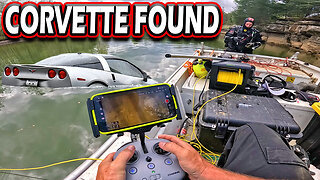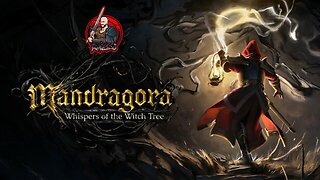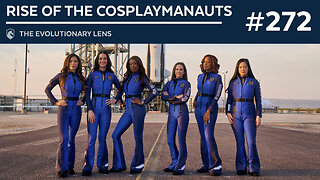Premium Only Content

🔴👀🔴 Take a Spin With NASA’s WFIRST Spacecraft
On schedule to launch in the mid-2020s, NASA’s Wide Field Infrared Survey Telescope (WFIRST) mission will help uncover some of the biggest mysteries in the cosmos. The state-of-the-art telescope on the WFIRST spacecraft will play a significant role in this, providing the largest picture of the universe ever seen with the same depth and precision as the Hubble Space Telescope.
The telescope for WFIRST has successfully passed its preliminary design review, a major milestone for the mission. This means the telescope has met the performance, schedule, and budget requirements to advance to the next stage of development, where the team will finalize its design.
WFIRST is a high-precision survey mission that will advance our understanding of fundamental physics. WFIRST is similar to other space telescopes, like Spitzer and the James Webb Space Telescope, in that it will detect infrared light, which is invisible to human eyes. Earth’s atmosphere absorbs infrared light, which presents challenges for observatories on the ground. WFIRST has the advantage of flying in space, above the atmosphere.
The WFIRST telescope will collect and focus light using a primary mirror that is 2.4 meters in diameter. While it’s the same size as the Hubble Space Telescope’s main mirror, it is only one-fourth the weight, showcasing an impressive improvement in telescope technology.
The mirror gathers light and sends it on to a pair of science instruments. The spacecraft’s giant camera, the Wide Field Instrument (WFI), will enable astronomers to map the presence of mysterious dark matter, which is known only through its gravitational effects on normal matter. The WFI will also help scientists investigate the equally mysterious "dark energy," which causes the universe's expansion to accelerate. Whatever its nature, dark energy may hold the key to understanding the fate of the cosmos.
In addition, the WFI will survey our own galaxy to further our understanding of what planets orbit other stars, using the telescope’s ability to sense both smaller planets and more distant planets than any survey before (planets orbiting stars beyond our Sun are called "exoplanets"). This survey will help determine whether our solar system is common, unusual, or nearly unique in the galaxy. The WFI will have the same resolution as Hubble, yet has a field of view that is 100 times greater, combining excellent image quality with the power to conduct large surveys that would take Hubble hundreds of years to complete.
WFIRST’s Coronagraph Instrument (CGI) will directly image exoplanets by blocking out the light of their host stars. To date, astronomers have directly imaged only a small fraction of exoplanets, so WFIRST’s advanced techniques will expand our inventory and enable us to learn more about them. Results from the CGI will provide the first opportunity to observe and characterize exoplanets similar to those in our solar system, located between three and 10 times Earth’s distance from the Sun, or from about midway to Jupiter to about the distance of Saturn in our solar system. Studying the physical properties of exoplanets that are more similar to Earth will take us a step closer to discovering habitable planets.
Music credit: “Phenomenon" from Above and Below
Written and produced by Lars Leonhard
Read more: https://www.nasa.gov/feature/goddard/...
Credits: NASA's Goddard Space Flight Center/Scott Wiessinger (USRA): Lead Producer
Michael Lentz (USRA): Lead Animator
Claire Andreoli (NASA/GSFC): Lead Public Affairs Officer
Francis Reddy (University of Maryland College Park): Science Writer
Ashley Balzer (GSFC Interns): Writer
Scott Wiessinger (USRA): Narrator
Scott Wiessinger (USRA): Editor
[insert full credits here as they appear on the SVS page]
This video is public domain and along with other supporting visualizations can be downloaded from the Scientific Visualization Studio at: http://svs.gsfc.nasa.gov/13295
If you liked this video, subscribe to the NASA Goddard YouTube channel: http://www.youtube.com/NASAExplorer
Follow NASA’s Goddard Space Flight Center
· Instagram http://www.instagram.com/nasagoddard
· Twitter http://twitter.com/NASAGoddard
· Twitter http://twitter.com/NASAGoddardPix
· Facebook: http://www.facebook.com/NASA.GSFC
· Flickr http://www.flickr.com/photos/gsfc
Subscribe now for more videos from over 280 sources plus my own videos!
Subscribe to my entertainment channel too or at least peek at my other channel !!! https://www.youtube.com/channel/UCiNFsoytAuun90UzU5AuxXg
https://www.bitchute.com/channel/YsJ0PYUWx5An/
https://www.patreon.com/user?u=26453564
-
 5:07
5:07
Kurt's News
1 month agoTrump Voters SHUT DOWN Lying CNN Host During Focus Group Panel
65 -
 17:23
17:23
Exploring With Nug
12 hours ago $5.17 earnedCorvette Found Underwater! Continuing The Search For Laresha Walker!
26.1K1 -
 LIVE
LIVE
BigTallRedneck
1 hour agoFORTNITE - THE QUEST FOR THE OPAL PICKLE
21 watching -
 24:55
24:55
MYLUNCHBREAK CHANNEL PAGE
8 hours agoDams Destroyed China
52.4K36 -
 LIVE
LIVE
Razeo
4 hours agoEpisode 3: 1st playthrough - Mandragora. What happens when The Pancake King goes eats Waffles?
32 watching -
 LIVE
LIVE
Joker Effect
51 minutes agoWHY IS EVERYONE SO ANGRY?! Just play on Motherland and have fun! Enjoy life!
304 watching -
 LIVE
LIVE
JFG | Rumble Edition
10 hours ago🔴LAWL OH LAWL | Crime Scene Cleaner | Rivals and More | #RumbleTakeover |
34 watching -
 56:28
56:28
Tactical Advisor
9 hours agoEx Content Creator Talks About Why He Quit | Vault Room LIve Stream 021
65.1K5 -
 2:28:24
2:28:24
Darkhorse Podcast
9 hours agoRise of the Cosplaymanauts: The 272nd Evolutionary Lens with Bret Weinstein and Heather Heying
49.3K92 -
![Nintendo Switch It UP Saturdays with The Fellas: LIVE - Episode #15 [Super Mario Bros. Wonder]](https://1a-1791.com/video/fww1/3d/s8/1/7/w/s/D/7wsDy.0kob-small-Nintendo-Switch-It-UP-Satur.jpg) LIVE
LIVE
MoFio23!
12 hours agoNintendo Switch It UP Saturdays with The Fellas: LIVE - Episode #15 [Super Mario Bros. Wonder]
96 watching